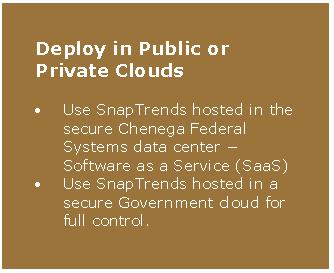 |
aboutSNAPTRENDS
System Description
SnapTrends is a data gathering tool for social media collection, monitoring, and analysis. Although many tools areavailable to collect information posted to Twitter, Instagram, Facebook, YouTube and FourSquare, it is difficult to find focused, pertinent information because these tools monitor only specific users or keywords, but do not focus on location. SnapTrends distinguishes itself because it provides accurate geospatial social media collection through its innovative, unique Listening Lens technology. With SnapTrends, analysts can monitor, collect, and analyze what is posted to social media in a specific area, as it is posted. The area can be of any shape or size -- an entire region, a city, a neighborhood, a park or a single house.
Capabilities:
SnapTrends provides the capability to automatically monitor and collect information from the most popular and active social media networks (Figure 1). It delivers current and historical activities of interest in formats that enable users to understand what is happening during critical events, comprehend what people are posting and predict potential outcomes.

With SnapTrends, an analyst defines exactly where to collect social media information by simply drawing one or more circles representing listening lenses, on a map (Figure 2). Analysts no longer spend valuable time scouring vast quantities of information at social media sites seeking activity of interest for a desired location. SnapTrends delivers the refined data on demand. The analyst benefits from more efficient collection of data relevant to sensitive areas: what previously took hours or days to accomplish is now available in near real-time.
Lenses can include any number of keywords to further focus data collection. Analysts can collect data for areas of any shape or in separated areas by combining multiple lenses in a collection mesh.
SnapTrends operates in two modes: Live Mode and Collected Data (Historic) Mode.
Live Mode: This mode is active when the analyst is viewing data with an unsaved Lens in a Profile. The data is not stored in the SnapTrends database. When the analyst creates a Lens, it collects Twitter posts for the previous 7 days and up to 12,800 social media posts with progressively older posting dates. After Lens creation, SnapTrends shows all collected posts. SnapTrends refreshes the map every 5 minutes or on demand by clicking on it.
Collected Data (Historic) Mode: Saving a Lens to a Profile starts collection with data stored in the SnapTrends database. When viewing data within a Profile the results are from everything the Lens has collected unless the analyst specifies a time range.
Why SnapTrends is a Unique and Superior Social Media Intelligence Solution
SnapTrends offers a unique and superior social media monitoring solution because of its patent pending, location based collection technology. There are two sources of data for social media collection: the "Firehose" services (e.g.Gnip) and the live, raw social media service provider application programming interface (API). While the Firehose does provide all social media data, it is neither as rich nor as useful for focused geo-location as the source API, nor always delivered in real-time.

SnapTrends enables analysts to visualize the collected data with various tools (Figure 3) including data management tools, geospatial tools, search, link analysis visualization, and analytics such as sentiment, alerting and reporting. SnapTrends provides these tools in a simple, easy-to-use HTML-based interface (Figure 4). CFS can integrate the tools into web frameworks like the Ozone Widget Framework (OWF), into desktop applications, or replace them with a customer's existing analysis tools. For example, if a link analysis tool is already in use, SnapTrends can integrate with it instead of duplicating functionality.

Deployment
The SnapTrends architecture is designed for cloud computing, using hardware virtualization and elastic scaling. All SnapTrends servers run on virtualized hardware, which provides an efficient use of customer information technology (IT) resources and reduces hardware cost through resource consolidation. The number of SnapTrends servers is provisioned using elastic scaling, and the system rapidly provisions IT resources based on user demand. This approach benefits the customer because it maximizes system flexibility, minimizes IT cycle times, and optimizes resource utilization.
Deployment can use the three-step process shown in Figure 5. With our CFS partner-hosted SnapTrends SaaS implementation, customers are able to use the software immediately and during the integration of the software into customer computing resources.